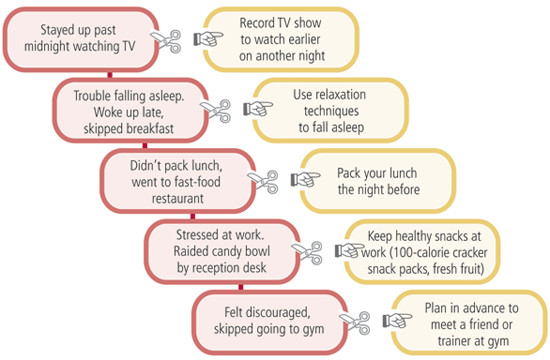Bridge the intention-behavior gap to lose weight and keep it off
What’s the hardest part of trying to lose weight? For most people, it isn’t figuring out what to eat and what to avoid—you know you need to scale down your portion sizes; focus on fruits, veggies, and whole grains; and hold off on the chips, donuts, and other high-calorie treats. The biggest challenge for most dieters is the “intention-behavior gap.” That’s the disconnect between knowing what you need to do and actually doing it. Or, as one of my friends once put it, “I know I shouldn’t eat an entire bag of fudge caramel gourmet popcorn. But it tastes so good!”
One way to bridge the intention-behavior gap is by using smaller plates and eating slowly. Another tried-and-true technique is writing down everything you eat each day, or recording it on a weight-loss app like Lose It! or Intelli-Diet. Doing this makes you more aware of what and how much you’re eating.
Another approach involves creating a behavior chain. This is a tool counselors sometimes use to help people recognize how a series of seemingly minor events can lead to an unfavorable outcome, such as overeating.
In the behavior chain I’ve posted here, notice the little missteps that lead to overeating and what can be done to break the chain, such as packing a lunch for work so you don’t need to hit the fast food restaurant down the street.
You can print out a blank behavior chain and fill in your own dietary downfalls. Think back to a time when you blew your diet and jot it down in the last red oval in the chain. Next, fill in the other red ovals with other circumstances earlier that day that might have played a role. Finally, brainstorm your own chain-breaking strategies and put them into the yellow ovals. Need some more suggestions? See this sample behavior chain diagram from Harvard-affiliated Brigham and Women’s Hospital.
You can read more behavior-focused changes in the 2011 edition of “Healthy Solutions to Lose Weight and Keep it Off.” At this link, you’ll find an excerpt and a Table of Contents for this new Special Health Report from Harvard Health Publishing.
About the Author

Julie Corliss, Executive Editor, Harvard Heart Letter
Disclaimer:
As a service to our readers, Harvard Health Publishing provides access to our library of archived content. Please note the date of last review or update on all articles.
No content on this site, regardless of date, should ever be used as a substitute for direct medical advice from your doctor or other qualified clinician.
















